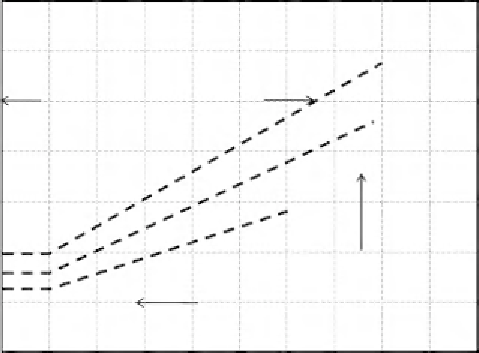Geology Reference
In-Depth Information
strong motion seismographs, attenuation laws have been derived for
different parts of the world. Forces are used for engineering design, so
acceleration is an important parameter. The equation below has been
shown to
fit the available European seismic data reasonably well and
can be used for prediction (Ambraseys
et al
., 1996). Data from North
America and elsewhere are not very different.
log
ðaÞ¼
−
1
:
48
þ
0
:
266M
s
−
0
:
922 log
ðrÞ
where a is peak horizontal ground acceleration expressed as a fraction
of gravitational acceleration, g, (9.81m/s
2
). M
s
is surface wave magni-
tude and r is essentially the distance between the project site and
the earthquake epicentre.
Figure 6.30
gives median data and can be
re
dence and for site characteristics (Ambraseys
et al
., 1996). Unexpectedly high accelerations do occur, and this is
often the result of local ground conditions or topography that amplify
the effect, as for the peak accelerations of 1.25g and 1.6g in the
abutment of Pacoima Dam, USA, during two separate earthquakes
(Bell & Davidson, 1996). The February 2011 earthquake that caused
huge damage in Christchurch, New Zealand, involved vertical ground
accelerations up to 2.2g and horizontal ground accelerations of up to
1.2g, which are very high for a 6.3M event and can be largely attrib-
uted to the very shallow nature of the earthquake (about 5 km,
according to the New Zealand Society for Earthquake Engineering).
Peak ground acceleration, although an important starting point, is
not enough to give an indication of structural performance. What also
matters is the time that the strong shaking continues and the frequency
spectrum of
ned for degree of con
the waves carrying the energy. The situation is
1.4
Figure 6.31
Predominant
different
magnitudes of
earthquake at
different distances
(US data).
Large earthquakes at
great distance: long
periods, low
frequencies dominate
1.2
M=8
1.0
1 Hz (same frequency as
ten-storey building)
M=7
0.8
Longer periods
might dominate
on soil sites
0.6
M=6
0.4
0.1
Near field, small
earthquakes with high
frequency dominanting
10 Hz (same frequency as
one-storey building)
0
0
40
80
120
160
200
240
280
320
360
400
Distance from causative fault - km



